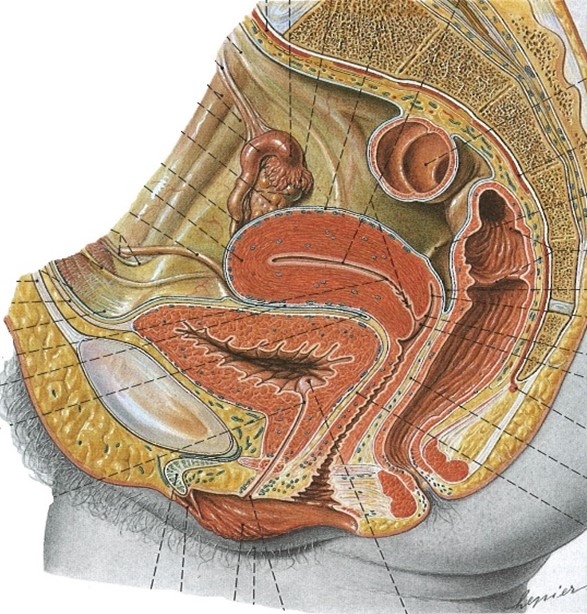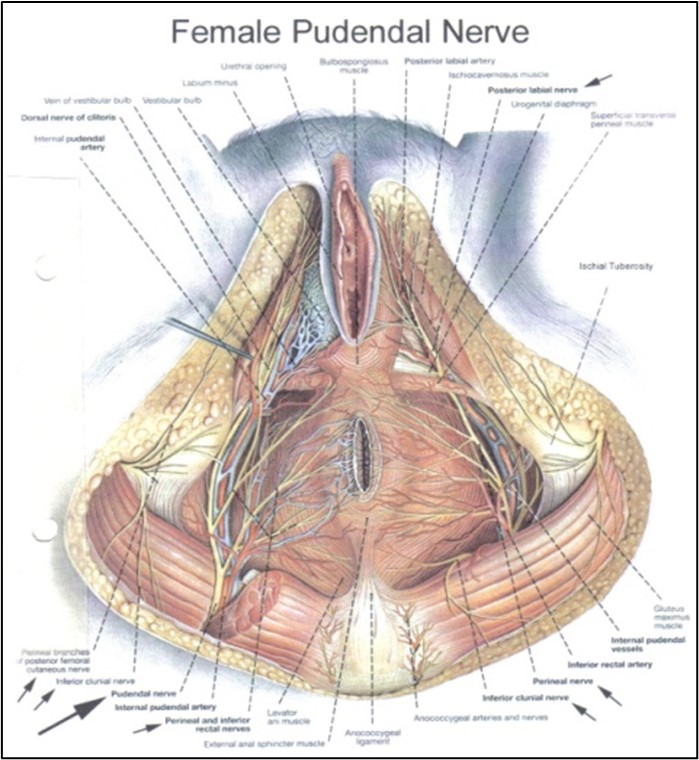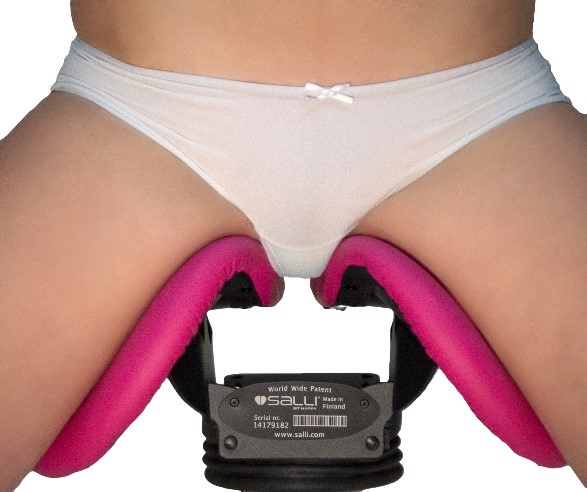Summary:
Normal = long-term sitting causes pressure in various tissues in the pelvic and inner thighs, poor blood, and lymph circulation. This causes loss of immunity, illnesses, functional disabilities, discomfort, and stress. Loose and well ventilating clothing, regular moving and standing and pelvic floor training habits together with divided swinging saddle chair can prevent and even heal developing health and functional problems.
We sit usually 12–16 hours a day. In the daytime an average woman is either sitting or walking to the next seat. Small breaks come from activities done in standing and the time spent in physical exercise. The main exception is mothers with young children.
Normal sitting in traditional chairs creates a major genital health threat for women. The problems appear outside and inside of the pelvic and floor (PF). Sitting puts pressure on the pressure-sensitive micro- and macro circulation in the blood and lymph vessels (about 700 km / 100 g of soft tissue), and in the lymph nodes.
Undisturbed circulation, which is generated by movements and muscle activity, is the basic factor to the metabolism and good health of any tissue.
In women sitting effects on ovaries, uterus, vulva, vagina, clitoris, urethra, bladder, anus, rectum, and colon. They are all close to the pelvic floor, supported by it, and kept up in their right place.
The following health problems relate to sitting:

When sitting, pressure is transmitted inside the pelvis through the pelvic opening. This increases the risk of internal pelvic diseases.

By sitting too much and in a wrong way, women weaken the sensitivity of the pudendal nerve, which effects on sex and anal reactions.
- Circulation disturbances appear inside the pelvic area. The chair padding creates pressure through the pelvic opening inside the pelvic area by pushing soft tissues (skin, fat, muscles, and connective tissue) into the space between the sit bones. The pressure spreads inside affecting on all internal pelvic organs.
- Cancer and other illnesses. 24 % of all cancer in women, and 47 % in men, occur in the “pelvic bowl”, which is just over 1 litre in women and just under 1 l in men. Poor circulation and pressure disturb metabolism and make tissues sourer, which is known to be a cancer risk. Besides cancer, many other illnesses develop.
- Inflammations in internal pelvic organs. Chair paddings increase the temperature and humidity in the vulva area, which helps the pathogens to move from the anal area to vulva and multiply. Poor circulation slows down the access of the immune cells to come to the area and destroy the pathogens that have slipped in through the thin skin. This way the inflammation gets a head start before the immune defence will stop it. Antibiotics are generally used to treat inflammation, which in turn, weaken immunity because of it´s microbe killing effect in the intestine.
- Problems with the pelvic floor muscles and rectum. When sitting on traditional chairs, we sit in a poor posture most of the time. The weight of the upper body increases pressure in the abdominal cavity. Poor posture increase the pressure. This pressure in turn, is the biggest risk for the gynaecological descend where all the internal pelvic organs flatten down, often Sitting pressure of all pelvic floor tissues against the chair padding disturbs also the normal functioning of the internal organs inluding anus and rectum.
- Pudendal nerve and p. vessel dysfunctions. These problems are most common amongst women who sit a lot on bicycle, horse saddle, or on an undivided saddle chair. The situation is even worse when the work requires leaning forward, like in dentistry and in laboratories, when the nerves are pressed against the pubic bone. In such conditions changes in the circulatory, nerval system may be expected, and the sensitivity to be weakened.
- Endometriosis develops during the conditions of the long-term sitting. All local defences are weakened due to the disturbed circulation and weakened immunity in the area.
How to avoid SD (sitting disorders) in the pelvic?
The main thing is to ensure, as much as possible, good micro lymph and blood circulation. It is also important to restore good ventilation and metabolic activity. The following measures are helpful and efficient:

The gap in the optimal Salli chair prevents the genitals from being harmfully pressed and provides a good ventilation of the area.
- Use of divided swinging saddle chair. With this kind of chair, the following benefits can be gained:
-
- The gap creates freedom from pressure for the pelvic floor and vulva (unlike normal or undivided saddle chair), and organs inside the pelvic.
- The gap itself restores better ventilation, which means lower temperature and dryer skin = smaller harmful microbe activity on the skin in the anal – genital area.
- The swing mechanism of the seat automatically increases physical activity of the pelvis and lower back, which in turn activates circulation and immune functions against inflammations inside the tissues.
- Saddle sitting (with the important gap where the pubic bone can go) helps one to get good posture. This decreases the pressure in the abdominal cavity and thus also the pressure on the internal pelvic organs from above.
- Good posture and the gap also help the rectum to function normally, decrease its diameter and thus decrease the pressure against the uterus, bladder, and vagina
2. Loose and cool clothes that don’t cause pressure in the pelvic area. Loose clothing helps circulation to function normally and does not get tight on the buttocks, crotch and genital, like many fashionable clothes do. This is meaningful also for the circulation of the lower extremities and lower stomach. Tights and underwear that leave red marks on the skin are harmful, the same as pressing belts. Trousers with middle seam digging deep between the labia is understandably bad for circulation and comfort. When you select clothes, test them in sitting position. Be sensitive and careful that they do not press you at all in your typical sitting position. All fabrics on the anal – genital area should be well ventilating. Long term pressure on the skin reduces valuable sensitivity
3. Physical activity. It´s very smart to have breaks during your sitting sessions; by talking on the phone, you can walk around (with earplugs) or, most preferably, go up and down stairs. Smart employers keep some exercise equipment (gym sticks, flexi bars, hand weights, kettlebells, stretching carpets, step boards, jumping rope) available in the workplace. During calls or informal meetings, you can do a so called “slow workout”. After a few minutes your circulation is increased for a long time, but you won’t get sweaty or breathless. This eliminates the “shutdown” of your body (and brain) caused by decreased circulation.
Becoming aware of the pelvic floor health, the condition of the PF muscles by testing and doing exercises to get them more relaxed and stronger, is part of the smart and wise personal health care too.
Truly satisfactory thing is, that you can decide and do all genital/pelvic health development by yourself 😊.
Veli-Jussi Jalkanen
Sitting and preventive Health Expert
